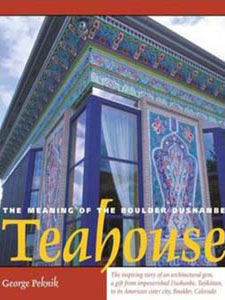Review: Meaning of the Boulder-Dushanbe Teahouse

The Dushanbe Tea House is no stranger to TeaMuse. Back in 2001, Martha Bowes profiled this architectural wonder of Boulder, Colorado, and in 2009 Christine Rillo visited and enjoyed the tea and atmosphere herself. But Adagio employees aren't the only people who are inspired and delighted by this teahouse. Examiner.com writer George Peknik was so inspired, he wrote a book about the teahouse in 2004.
Similar to the story Peknik had heard about a fluttering mosque that had been magically transported by Allah from Bahla, Oman, to a nearby city, the Dushanbe Teahouse was transported from Dushanbe, Tajikistan, to Boulder, it's sister city. The Meaning of the Boulder-Dushanbe Teahouse is Peknik's chronicle of "Boulder's 'fluttering teahouse.'"
Peknik wrote the book for four reasons, which he outlines in the introduction: to inform readers about the teahouse so that they might develop an understanding and appreciation of Muslim cultures; to explore the message behind Dushanbe Mayor Maksud Ikramov's generous gift; to honor the "citizen diplomats" who helped make the Boulder-Dushanbe Teahouse a reality; and to share the story of Boulder's reciprocal gift, a cyber café. The book accomplishes all of Peknik's objectives.
The Meaning of the Boulder-Dushanbe Teahouse is a painstakingly researched and lovingly crafted tribute to the only Tajik teahouse in the Western hemisphere. Peknik complements his in-depth descriptions of the look and meaning of the architecture of the teahouse with beautiful, colorful images and drawings. The pictures of the hand-painted and hand-carved teahouse elements that were created in Tajikistan and shipped to Boulder for re-assembly give readers an appreciation for the craftsmen and designers that is second only to seeing the teahouse in person. Peknik explores traditional Persian/Tajik design and the significance and meaning of various elements of the teahouse. He also details the cultural context of teahouses in Central Asian and Persian cultures as meeting places and spiritual domains, and the importance of their aesthetic appeal. He even devotes an entire chapter to Tajikistan and Tajik people.
A notable section entitled "The History of the Boulder-Dushanbe Teahouse" explains how the two cities, which are 7,000 miles apart, became sister cities in the 1980s through the Soviet Sister Cities Project (SSCP). It also provides the background of how Dushanbe came to offer a teahouse to Boulder and the amazing efforts on both ends that helped bring the dream of the teahouse to fruition. After more than 10 years of connecting and planning, and overcoming obstacles and opposition, the Dushanbe Teahouse opened in 1998. Peknik captures the specifics of the story to honor the efforts made by so many, and to honor the finished product.
If ever you're going to be in Boulder, be sure to visit the Boulder-Dushanbe Teahouse to enjoy the architectural marvel, rich heritage, and wonderful food and tea. Also, be sure you pick up a copy of The Meaning of the Boulder-Dushanbe Teahouse first, so you can fully appreciate the symbolism and how this treasure came to be.
